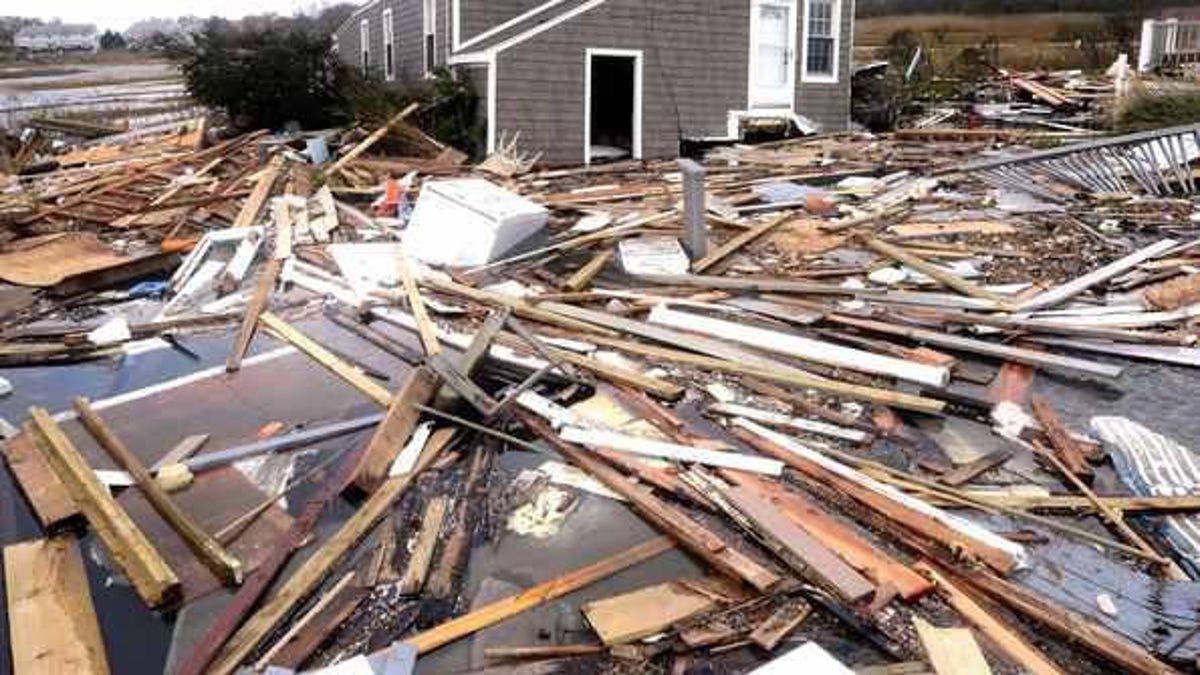
Oct. 30, 2012: Debris floats around a house pushed off its foundation in the aftermath of superstorm Sandy in East Haven, Conn. (AP)
Washington – A $60.4 billion spending bill washed up in Washington this week aimed at bringing help to communities hardest hit by Superstorm Sandy.
But a closer look at the legislation shows millions of dollars being requested by lawmakers for projects that have little to do with the storm. Some items, like a proposed $2 million roof restoration for the Smithsonian Institution, even pre-date Sandy, causing some to question the finer details of the federal funding package.
“How much is absolutely needed now? That’s all we should really be considering now, the short-term needs,” said Sen. Ron Johnson, R-Wis., who has called the $60 billion request “absurdly high.”
While most of the money -- $47.4 billion – would immediately go to help Sandy victims and rebuilding efforts, the pet projects around the edges could cause consternation.
Tucked in the bill is a $41 million request for repairs at eight military bases, including Guantanamo Bay, Cuba. Customs and Border Protection has asked for $2.4 million to replace "destroyed or damaged vehicles, including mobile X-Ray machines." The bill includes a $4 million repair job at the Kennedy Space Center in Florida.
An additional $13 billion has also been added in to protect against future storms, a cost some Republican lawmakers say isn’t emergency-related and should be scaled back.
Other sweeteners include $150 million for fisheries in Alaska and the Gulf of Mexico, and $125 million for a Department of Agriculture program that would help Colorado cope with summer wildfires.
Complicating matters are the ongoing fragile negotiations between President Obama and House Speaker John Boehner over spending cuts, tax increases and efforts to avert the looming fiscal crisis.
The Senate is scheduled to start debating the Sandy bill Monday afternoon but the measure as a whole faces a tough fight in Congress. Fiscal conservatives are hesitant to approve such a large spending bill, especially after slamming Democrats for playing fast and loose with federal dollars. Republicans want new spending to be offset by spending cuts or tax increases elsewhere in the budget.
The Obama administration and several Democrats say that emergency spending is a one-time expense and that it makes sense to add it to the government’s tab. What they don’t address are provisions planted in the bill that aren’t storm related, such as infrastructure projects in states more than a thousand miles away from where Sandy hit.
Sen. Mark Begich, D-Alaska, asked for funds to clean up marine debris washing up on the West Coast from the Japan earthquake in March 2011. Calls to his office for comment were not immediately returned.
So far, the federal government has spent about $2 billion in the 11 states affected by the storm.
The Congressional Budget Office estimates that only $9 billion of the $60.4 billion proposed would be spent over the next nine months. An additional $12 billion would be spent the following year. Republicans say the CBO’s estimate undercuts the urgency of the bill.
Others, though, are softening their stance. “We’d be wise to do offsets but this is truly an emergency,” Sen. Lindsey Graham, R-S.C., said. “I’d like to try to find offsets but at the end of the day this is a catastrophic event in a huge population center.”
On Sunday, the governors of New York, New Jersey and Connecticut wrote an op-ed piece in the Washington Post calling on Congress to provide aid and arguing that “in times of crisis no region, state, or single American should have to stand alone or be left to fend for themselves.” They added that while the nation “faces significant fiscal challenges,” Congress should “not allow this much-needed aid to fall in to the ideological divide.”




